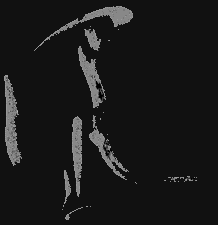2. Marginal Arts
Shunsuke Tsurumi's Marginal Art

The term "marginal art" was coined by the philosopher Shunsuke Tsurumi to refer to the vast realm that lies on the borderline between art and life, art that is created not by professional artists but by non-professional artists and enjoyed by the masses [1]. Tsurumi classifies art into three categories: "pure art," "popular art," and "marginal art.
Tsurumi defines marginal art as artistic expressions that have arisen in people's minds, spilled out, and changed form in their daily lives since the mural painting in Altamira 5,000 years ago, such as graffiti, folk songs, bonsai, manzai, ema, fireworks, dodoitsui, and manga [2]. According to Tsurumi, Kunio Yanagida, Muneyoshi Yanagi, and Kenji Miyazawa can be regarded as pioneers of marginal art.
According to Tsurumi's view, marginal art, in other words, is art that is outside the coordinate system of center and periphery (edge). If this is art that is on the edge of ceasing to be art, Kiyokazu Washida says that it could include popular culture, Marcel Duchamp's "Fountain," and John Cage's "4 minutes and 33 seconds.
*Art is a symbol that directly creates aesthetic experiences and experiences.
*Aesthetic experience is considered to have the same extensibility as direct value experience.
*In the vast area that lies at the boundary between art and life, art created not by professional artists, but by
non-professional artists, and enjoyed by the masses, is called "marginal art.
*Art" is classified into pure art, popular art, and marginal art.
*Pure art is created by professional artists and has a "professional" audience that is familiar with the series of works of each professional discipline.
*Popular art is also created by professional artists, but its production process is more of a collaboration between corporation and professional artists, and its audience is intended to be the masses.
*Marginal art is imagined by non-specialist artists and enjoyed by non-specialist audience.
The elements that sharply divide art into pure art and popular art have been at work since the birth of the professional artist in Greece in ancient times. In the 20th century, with the development of "mass communication" and the establishment of democratic political and economic systems on a global scale, the division between pure art and popular art became decisive.
Contrary to this, marginal art has continued to this day without any extreme progress, as exemplified by the murals of Altamira.
References:
Tsurumi, Shunsuke, Marginal Art Theory, Keiso Shobo, 1967.
Tsurumi, Shunsuke, "Marginal Art Theory Revisited," in Noboru Kawazoe (ed.), Gendai Design Koshu 4 Design no Chiiki, Fudosha, 1969.
Shunsuke Tsurumi, "On the Symbolic Association," in Shunsuke Tsurumi, Symbolic Theory, Chikuma Shobo, 1969.
Shunsuke Tsurumi, The Collected Works of Shunsuke Tsurumi 4: The Arts, Chikuma Shobo, 1975
Shunsuke Tsurumi, Marginal Art, Kodansha Academic Library, 1976
Shunsuke Tsurumi, "Yanagi Muneyoshi," in Shunsuke Tsurumi Vol. 2: The Forerunners, Chikuma Shobo, 1987
Shunsuke Tsurumi, The Theory of Marginal Art, Chikuma Shobo, 1991
Nozomu Ikeyi, "Comparative Marginal Art Theory," in Shun Inoue and others (eds.), The Sociology of Japanese Culture, Iwanami Shoten, 1996.
Awatani, Yoshiji, "A History of Media Culture from the Perspective of Marginal Art Theory: Shunsuke Tsurumi, Folk Music, and Local Culture," Bulletin of the Institute for Media and Communications Research, Keio University, No. 61, 2011.
Footnotes:
1. Shunsuke Tsurumi, Marginal Art Theory, Chikuma Gakuen Bunko 1999, p.462
2. Kentaro Miwa, Manga to Eiga [Manga and Movies], NTT Publishing, 2014, p.22
3. Kiyokazu Washida, "Reasons for "Gusu Gusu"", Kadokawa Shoten, 2013, p.22.
(Some excerpts from Wikipedia-Japan)
